16+ Sample Classroom Observation Checklist
-

Classroom Observation Checklist Template
download now -
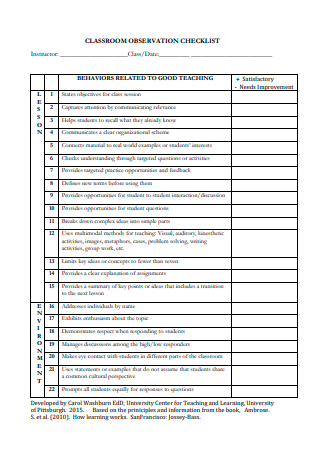
Basic Classroom Observation Checklist
download now -
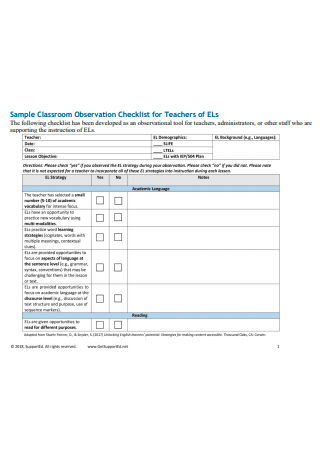
Teachers Classroom Observation Checklist
download now -

Formal Classroom Observation Checklist
download now -
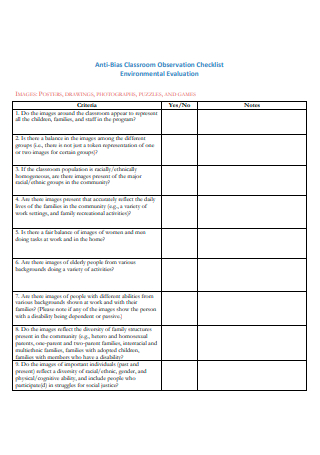
Classroom Observation Checklist Example
download now -

Regular Classroom Observation Checklist
download now -
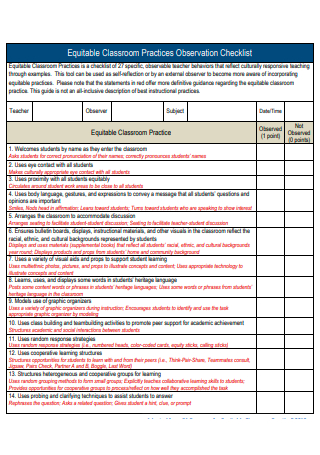
Classroom Practices Observation Checklist
download now -
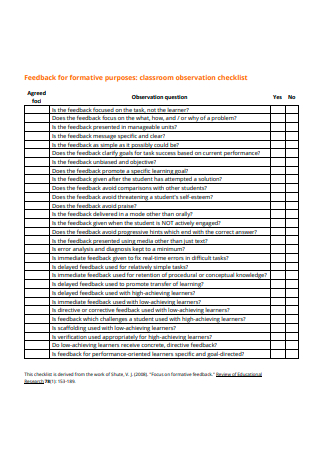
Classroom Observation Checklist in PDF
download now -

Classroom Teaching Observation Checklist
download now -
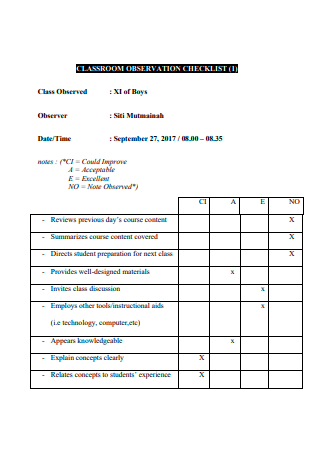
Standard Classroom Observation Checklist
download now -
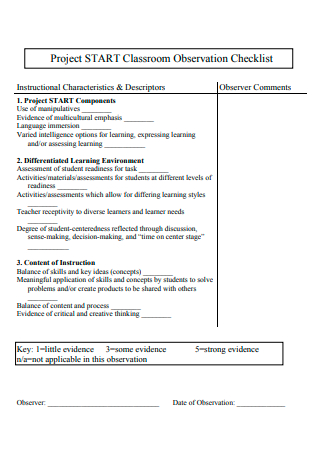
Project Start Classroom Observation Checklist
download now -
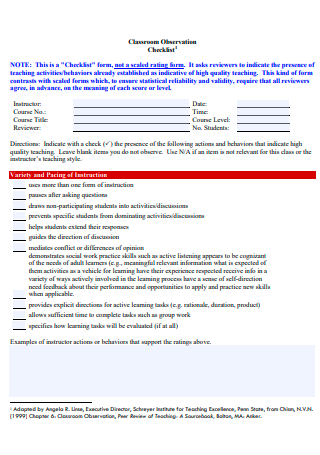
Printable Classroom Observation Checklist
download now -
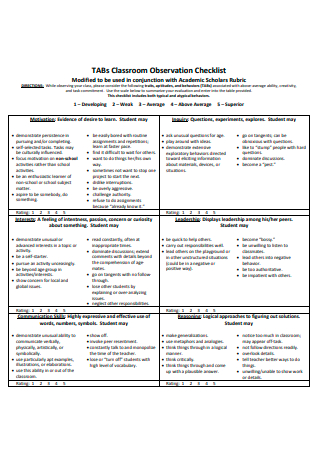
Classroom Observation Checklist Format
download now -
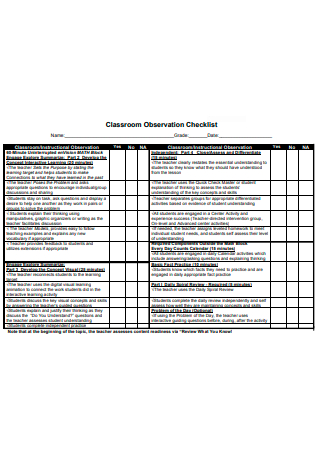
Draft Classroom Observation Checklist
download now -

Classroom Teacher Observation Checklist
download now -
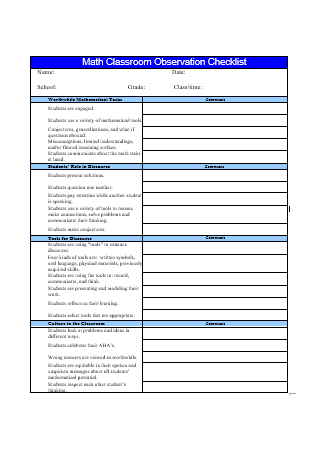
Math Classroom Observation Checklist
download now -
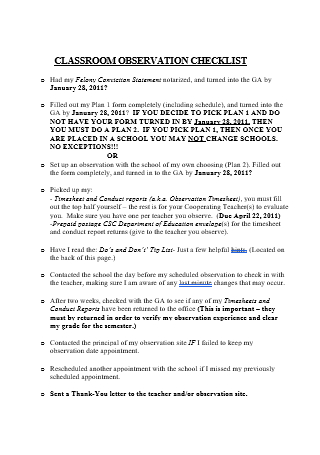
Classroom Observation Checklist in DOC
download now
FREE Classroom Observation Checklist s to Download
16+ Sample Classroom Observation Checklist
What IS a Classroom Observation Checklist?
The Payoffs of Having Good Classroom Management
How to Make that Effective Classroom Observation Checklist
FAQs
What are some of the purposes of a classroom observation?
What are some of the things you need to prepare before observing a class?
What are some of the different classroom observation methods?
What IS a Classroom Observation Checklist?
Every procedure needs guidance, or in this case, a checklist. Same in the classroom setting. Teachers, or educators, are guided by a set of checklists to ensure that proper procedures are met when it comes to teaching, learning, classroom set up and protocol, including tracking and monitoring students’ progress. This is what a classroom observation checklist is all about. It is a guide for an observer to use on how to properly assess the overall classroom setup and performance. The checklist allows for an in-depth assessment of classroom procedures and activities that ultimately affects a student’s learnings and performance, sort of a compliance checklist. A checklist could help identify areas in learning that needed improvement, and even help create criteria on how to monitor students’ learning progress. A classroom observation checklist is a classroom roadmap on how to gauge classrooms’ learnings, activities, and environment.
The Payoffs of Having Good Classroom Management
How you, as a teacher, manage your classroom is a reflection of your student’s outcomes in school, and even in life. Classroom management is somewhat akin to business management planning. There is a structure that needs to be organized. Some people need to be managed. Some resources need to be kept and maintained. And, some goals and objectives need to be achieved. There are a lot of reasons why there is a need to have good classroom management in place. Some of those reasons might not seem significant at first, but you’ll, later on, realize that the domino effects of classroom management are bigger than life. But why even go through the fuss of ensuring that you have an effective classroom management structure? Read on to find out why.
How to Make that Effective Classroom Observation Checklist
We have talked about classroom observation as a roadmap, a guide for an observer on how a classroom should be managed, run, and even prepared effectively and conducive to classroom learning. Classroom observation can be done as part of a teacher’s job evaluation or as part of the school’s improvement drive on a teacher’s performance or conduct inside a classroom which includes student relationships and teaching methods used. Although there is no hard and fast rule when it comes to creating a classroom observation checklist, still, the checklist should contain the core message or the core purpose of the checklist itself, which means that checklists should be flexibly drafted according to their purpose. Below are the following elements that are typically included when creating a classroom observation checklist.
-
1. Title of the Checklist
A one-liner title description of the classroom observation you will be doing. Usually, the title should also depict the purpose of the observation. A concise title description is a preferred way of creating one. Some examples of titles are (school name) Peer Observation Report; Observation Instrument; Dyslexia Teacher Observation Checklist; Teacher Assistant Observation Checklist; and/or Math (or any subject) Teacher Observation Checklist.
-
2. Observer’s and Participant’s Details
The next following lines should contain the name of the participant to the observation, such as the teacher’s name, and the name of the person conducting the observation. Other details that need to be included and recorded are the date when the observation was conducted, the time, the classroom number or details pertinent to the venue of the observation, the class number or type, or whatever the appropriate description is (such as kindergarten, grade 1, and so on), as well as the number of students present during the observation.
-
3. Instructions
The next line should contain the instructions on how the observation should be done and the checklist should be answered. This is where specific details on how the observation should be made are provided in detail, such as the observation conducted should be on the teacher’s lesson plan used or the teaching methods, and so on.
-
4. Checklist Content
A common checklist is usually done in question-type with a column selection of yes or no format, a score sheet, or a rating format such as rate according to 1, 2, 3, with 1 being the non-conforming answer, and 3 being the highest conforming. In other checklists, a comment, feedback report, or suggestion column is also added after the scoring or rating column. The comment column allows for the observer to add thoughts or opinions explaining why such a score or rating was given, and even allows the observer to provide suggestions for improvement.
FAQs
What are some of the purposes of a classroom observation?
Classroom observations are integrated as an important part of any educational institution. One purpose of having a classroom observation is to help improve a teacher’s teaching ability through the scoring, rating, or feedback being given by the observer. This, in turn, impacts the overall students’ learning environment as well. Another purpose of doing the observation is that it serves as a survey for research institutions to help schools improve educational practices, to improve schools’ environment, or to help come up with solutions to existing school or classroom practices.
What are some of the things you need to prepare before observing a class?
You need to first specify the reason or purpose for doing the observation. Next is to identify which class to observe, or who is the subject of your observation. Afterward, set the schedule, the date, and the time of when you will be conducting the observation, and notify your participant. Next is preparing the classroom observation checklist. Once you’re done with the observation, make sure to record, assess, and analyze the information you’ve collected and the observation you’ve made to properly support your findings, conclusions, and recommendations.
What are some of the different classroom observation methods?
Some of the classroom observation methods, aside from the checklists, are questionnaires (both closed-ended and open-ended), surveys, charts, scoring or rating systems, narrative observation, and so on.
A classroom is where it all starts. Early life training is done in classrooms, aside from their homes. Students not only learn in terms of curriculum, but they also learn life skills and personality development which determines how they soon will grow up to be in life. That is why creating the right, conducive, and proper learning environment is important when it comes to education. Hence, the reason why classroom activities are conducted is based on a given set of procedures or requirements. These are all made sure to be implemented through timely observation conducted by the proper authorities. And what they use to ensure that everything is met according to standard procedures is a Classroom Observation Checklist document.
Download our classroom observation checklist templates. Let our checklist templates assist you in creating that efficient and effective classroom observation process!
